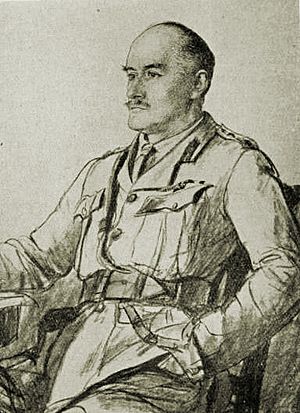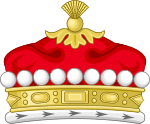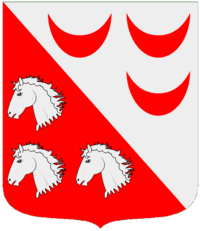Edmund Allenby, 1st Viscount Allenby facts for kids
Quick facts for kids
The Viscount Allenby
|
|
|---|---|
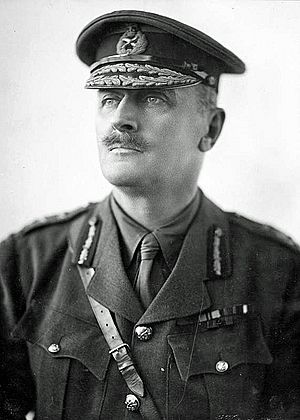
Field Marshal Viscount Allenby
|
|
| High Commissioner in Egypt | |
| In office 1919–1925 |
|
| Monarch | George V |
| Preceded by | Reginald Wingate |
| Succeeded by | George Lloyd |
| Personal details | |
| Born | 23 April 1861 Brackenhurst, Nottinghamshire, UK |
| Died | 14 May 1936 (aged 75) London, UK |
| Spouses | Adelaide Mabel Chapman, Viscountess Allenby of Megiddo |
| Awards | Knight Grand Cross of the Order of the Bath Knight Grand Cross of the Order of St Michael and St George Knight Grand Cross of the Royal Victorian Order Full list |
| Nickname | The Bloody Bull or The Bull |
| Military service | |
| Allegiance | United Kingdom |
| Branch/service | British Army |
| Years of service | 1880–1925 |
| Rank | Field Marshal |
| Commands | Egyptian Expeditionary Force British Third Army V Corps Cavalry Corps 1st Cavalry Division 4th Cavalry Brigade 5th Royal Irish Lancers 6th (Inniskilling) Dragoons |
| Battles/wars | |
Field Marshal Edmund Henry Hynman Allenby, 1st Viscount Allenby (born April 23, 1861 – died May 14, 1936) was a very important British Army officer. He was also an Imperial Governor. He fought in two major conflicts: the Second Boer War and the First World War. During the First World War, he led the British Empire's Egyptian Expeditionary Force (EEF). This force fought against the Ottoman Empire in the Sinai and Palestine Campaign. They successfully took control of Palestine.
From October to December 1917, the British captured important cities like Beersheba, Jaffa, and Jerusalem. In the summer of 1918, Allenby's forces took the Jordan Valley. Later, they captured northern Palestine. They defeated the Ottoman army at the Battle of Megiddo. This forced the Ottoman armies to retreat towards Damascus. The EEF then captured Damascus and moved into northern Syria.
During this advance, Allenby commanded T. E. Lawrence (known as "Lawrence of Arabia"). Lawrence and Faisal's Arab forces helped the EEF capture Ottoman lands. The campaign ended on October 30, 1918. After the war, Allenby continued to serve in the region. He was the High Commissioner in Egypt from 1919 to 1925. This meant he was effectively in charge of Egypt during that time.
Contents
Early Life and Military Start
Allenby was born in 1861. His parents were Hynman Allenby and Catherine Anne Allenby. He went to Haileybury College. He didn't originally want to be a soldier. He tried to join the Indian Civil Service but didn't pass the exam.
In 1880, he took the exam for the Royal Military College, Sandhurst. He passed and became a lieutenant in the 6th (Inniskilling) Dragoons in 1882. He joined his regiment in South Africa that same year. He took part in the Bechuanaland Expedition in 1884–85. He was promoted to captain in 1888 and returned to South Africa.
Allenby came back to Britain in 1890. He tried to get into the Staff College in Camberley but failed the first time. He tried again the next year and succeeded. He became a major in 1897. He was then posted to the 3rd Cavalry Brigade in Ireland.
Fighting in the Second Boer War
The Second Boer War began in October 1899. Allenby rejoined his regiment and sailed to South Africa. He took part in battles at Colesberg, Klip Drift, and Dronfield Ridge in early 1900. His actions were praised by the commander, Lord Roberts.
Allenby, now a major, was put in charge of a group of New South Wales Lancers. They were camped near Bloemfontein. It rained a lot, and many soldiers got sick. Allenby was known for being very strict.
He continued to fight in battles like Zand River and Barberton. He defeated the Boer General Jan Smuts at Tevreden. He was promoted to local lieutenant-colonel in 1901 and local colonel later that year. Lord Kitchener, who was in charge later in the war, called him "a popular and capable Cavalry Brigadier". For his service, he received the Companion of the Order of the Bath (CB) award.
Between the Wars
Allenby returned to Britain in 1902. He became the commanding officer of the 5th Royal Irish Lancers in Colchester. He was promoted to the rank of colonel and then to temporary brigadier general in 1905. In 1906, he took command of the 4th Cavalry Brigade.
He became a major-general in 1909. In 1910, he was made Inspector-General of Cavalry. This was because of his wide experience with cavalry. He earned the nickname "The Bull" because he was very tall and strong. He also had a bad temper and would sometimes shout at his officers. This made him a bit scary to those who worked for him.
First World War Service
During the First World War, Allenby first served on the Western Front. In August 1914, a British Expeditionary Force (BEF) was sent to France. Allenby commanded its cavalry division. This division helped cover the retreat after the Battle of Mons. They fought well at the First Battle of Ypres with limited supplies.
On the Western Front
Allenby was promoted to temporary lieutenant general in October 1914. As the BEF grew, he became commander of the Cavalry Corps. In May 1915, Allenby took command of V Corps. This corps was fighting hard at the Second Battle of Ypres. His temper seemed to get worse during this time. V Corps won the battle but suffered many losses.
In September 1915, V Corps launched a small attack in the Ypres Salient. This was to help another British attack. This also resulted in many casualties. In October 1915, Allenby was promoted to lead the British Third Army. He became a full lieutenant-general in January 1916. In mid-1916, he supported the start of the Battle of the Somme. His troops tried to attack the Gommecourt fortress but failed with heavy losses.
Some of Allenby's officers thought he was only capable of rage. However, he was a loving father and husband. He worried deeply about his only son, Michael, who was also fighting. Every night, Allenby would ask if there was any news of his son. His son, a lieutenant, died from wounds in July 1917 at age 19. Allenby was heartbroken but kept working with strong determination.
In early 1917, Allenby was told to prepare for a big attack near Arras. He used new ideas from his staff officers. Instead of a week-long bombardment, he planned a 48-hour one. He also made careful plans for traffic and supplies. New weapons like tanks and aircraft were to be used. In March 1917, the Germans moved back to the Hindenburg Line. Allenby wanted to change his plans, but his commander, Sir Douglas Haig, refused. Haig told him he would be responsible if the attack failed.
The Arras offensive started well on April 9, 1917. The Third Army broke through German lines and advanced quickly. Allenby wrote to his wife that he had a "very big success." But the battle turned into trench warfare with many casualties. Allenby lost Haig's trust. He was promoted to full General in June 1917. But he was replaced as head of the Third Army and sent back to England.
In Egypt and Palestine
A New Strategy for Britain
In May 1917, British leaders debated where to focus their efforts in the war. Some, like Curzon, wanted Britain to gain ground in the Middle East. Prime Minister David Lloyd George also wanted more action outside the Western Front. They had been worried about taking Palestine before. But repeated losses to the Turkish Army and the stalemate in France changed their minds.
Lloyd George wanted a "dashing" commander for the Egyptian Expeditionary Force. He chose Allenby for this role. Allenby thought it was a joke at first. He still believed the war would be won on the Western Front.
The Palestine Campaign Begins
Allenby arrived in Egypt on June 27, 1917. On July 31, he learned his son Michael had been killed. He was very sad but kept working hard. Allenby understood the challenges of getting supplies and water in the desert. He worked to make sure his soldiers always had what they needed. Getting water to the troops was one of his biggest achievements. He also made sure there were good medical facilities.
Allenby quickly earned the respect of his troops. He often visited the front lines, unlike his predecessor. He moved the EEF's main headquarters closer to the front. He also supported the use of Arab forces. These forces were led by a young British officer named T. E. Lawrence. Allenby gave Lawrence money to help his work with the Arab tribes.
Allenby won the Third Battle of Gaza (October 31 – November 7, 1917). He surprised the Turkish defenders by attacking Beersheba. He used fake radio messages and even a staged incident with a "lost" bag of fake plans. This made the Turks think the British would attack Gaza. Instead, the British captured Beersheba and its water supply. This allowed them to push forward through the desert.
Capturing Jerusalem
Allenby's forces moved north towards Jerusalem. The Ottomans were defeated at Junction Station. They retreated from Jerusalem, which was captured on December 9, 1917.
When Allenby entered Jerusalem, he did so on foot through the Jaffa Gate. He walked with his officers. This was a deliberate contrast to the German Kaiser, Wilhelm II, who had ridden into Jerusalem on horseback in 1898. Allenby wanted to show respect for Jerusalem as a Holy City for Judaism, Christianity, and Islam. The people of Jerusalem saw his entry on foot as a sign of his modesty.
The British press sometimes called the campaign a "Crusade." But Allenby discouraged this. He wanted to avoid upsetting the Muslim population. He insisted he was fighting the Ottoman Empire, not Islam. He said Jerusalem's importance was strategic, not religious.
In May 1918, Allenby met with Chaim Weizmann and the Chief Rabbi of Jerusalem in Jerusalem.
Defeating the Ottoman Empire
After Jerusalem fell, Allenby was asked if he could conquer all of Palestine. He said he could with his current forces. But he would need many more divisions to advance further to Damascus and Aleppo. This was to cut off Turkish communications.
New troops from the British Empire arrived in August 1918. These included soldiers from Australia, New Zealand, India, and South Africa. The Ottoman line was broken at the Battle of Megiddo (September 19–21, 1918). Allied cavalry then moved through and blocked the Turkish retreat. The EEF advanced very quickly. Damascus fell on October 1, Homs on October 16, and Aleppo on October 25. The Ottoman Empire surrendered on October 30, 1918.
Governor of Egypt
Allenby was made a field marshal in July 1919. He was also given the title Viscount Allenby.
In 1919, he became the Special High Commissioner of Egypt. At this time, Egypt was facing protests against British rule. Several Egyptian leaders, including Saad Zaghlul, had been sent away. These actions led to riots across the country. Allenby's first step was to try to make peace. He allowed Zaghlul and his group to travel to France.
In early 1921, there were more riots. Allenby ordered Zaghlul and other leaders to be sent away again. The next year, Allenby went to London with his own ideas. He wanted to end martial law in Egypt. He also wanted a new Egyptian Constitution and for Zaghlul to return. Egypt was given some self-government. A new constitution was published in October 1922. This led to a government led by Zaghlul in January 1924.
In November 1924, the commander of British forces in Egypt, Sir Lee Stack, was killed. Allenby reacted very strongly. He demanded a large fine from the Egyptian Government. In May 1925, Allenby resigned and went back to England.
Later Life and Death
Allenby retired to England. He was appointed Honorary Colonel of the Cinque Ports Fortress Royal Engineers in 1925.
In 1931, Allenby gave lectures about the Palestine Campaign. He discussed whether it was worth moving troops from the Western Front to Palestine. He noted that in 1917 and 1918, it was not clear the Allies would win the war. He believed it was smart for Britain to gain land in the Middle East. This would block Germany's path to India.
Allenby died suddenly on May 14, 1936, at his home in London. He was 75 years old. His ashes were buried in Westminster Abbey.
Family Life
In 1897, Allenby married Adelaide Chapman. Their only child, Lieutenant Horace Michael Hynman Allenby, was killed in action in Flanders in 1917. He was serving with the Royal Horse Artillery. He was only 19 years old. The words on his gravestone are from a poem by Walt Whitman.
Since Allenby had no other children, his title passed to his nephew, Lt-Col. Dudley Allenby, after his death.
Tributes and Legacy
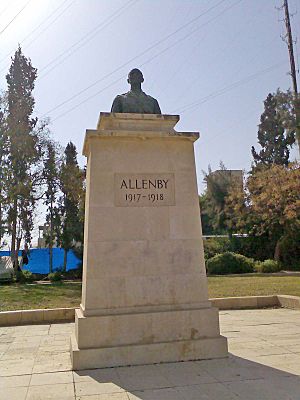
Allenby once supposedly said that people would need to visit a museum to learn about him. But T. E. Lawrence would be remembered by everyone. This quote was used in the 1962 film Lawrence of Arabia. A blue plaque in London marks Allenby's former home.
Allenby was very famous in Britain right after the First World War. He was also well-known in the United States. He and his wife toured America in 1928. He received a standing ovation when he spoke at Carnegie Hall in New York City.
The epic film Lawrence of Arabia shows the Arab Revolt during World War I. Allenby is a major character in the film.
T. E. Lawrence himself spoke highly of Allenby. He described Allenby as "physically large and confident, and morally so great."
Some historians believe Allenby was one of Britain's most important generals. He used new tactics like air power, motorized forces, and irregular fighters led by Lawrence. This made him a very modern commander. He also had to act like a politician, keeping many different groups of soldiers working together. By defeating the Ottomans, Allenby helped create the modern Middle East. Without his victories, countries like Israel, Jordan, Syria, Lebanon, and Iraq might not exist today.
Honours
British Awards
- Knight Grand Cross of the Order of the Bath (GCB) – 1918
- Knight Grand Cross of the Order of St Michael and St George (GCMG) – 1917
- Viscount Allenby of Megiddo and of Felixstowe – 1919
- Knight of Justice of the Venerable Order of Saint John (KStJ) – 1925
- Knight Grand Cross of the Royal Victorian Order (GCVO) – 1934
Campaign and Commemorative Medals
- Queen's South Africa Medal
- King's South Africa Medal
- 1914 Star and bar
- British War Medal
- Victory Medal
- King George V Coronation Medal
- King George V Silver Jubilee Medal
Other Awards
- Grand Officer of the Legion of Honour of France
- Belgian Croix de Guerre
- Grand Cross of the Order of the White Eagle with Swords of Serbia
- Grand Cross of the Order of the Redeemer of Greece
- Croix de Guerre of France
- Army Distinguished Service Medal of the United States
- Grand Officer of the Military Order of Savoy of Italy
- Grand Cross of the Order of the Crown of Romania
- Order of Wen-Hu, 1st Class of the Republic of China
- Order of the Renaissance, 1st Class with Brilliants of the Kingdom of Hejaz
- Order of Michael the Brave, 1st Class of the Kingdom of Romania
- Grand Cordon of the Order of the Rising Sun of Japan
- Grand Cordon of the Order of the Paulownia Flowers of Japan
- Grand Cross of the Order of Leopold of Belgium
Arms
|
See also
 In Spanish: Edmund Allenby para niños
In Spanish: Edmund Allenby para niños
- Allenby Bridge
- Allenby Gardens, South Australia
- Allenby Square, Jerusalem
- Allenby Street, Tel Aviv
- Allenby, British Columbia
- Allenby, Toronto
- Mandatory Palestine
- Victory Services Club
Images for kids


